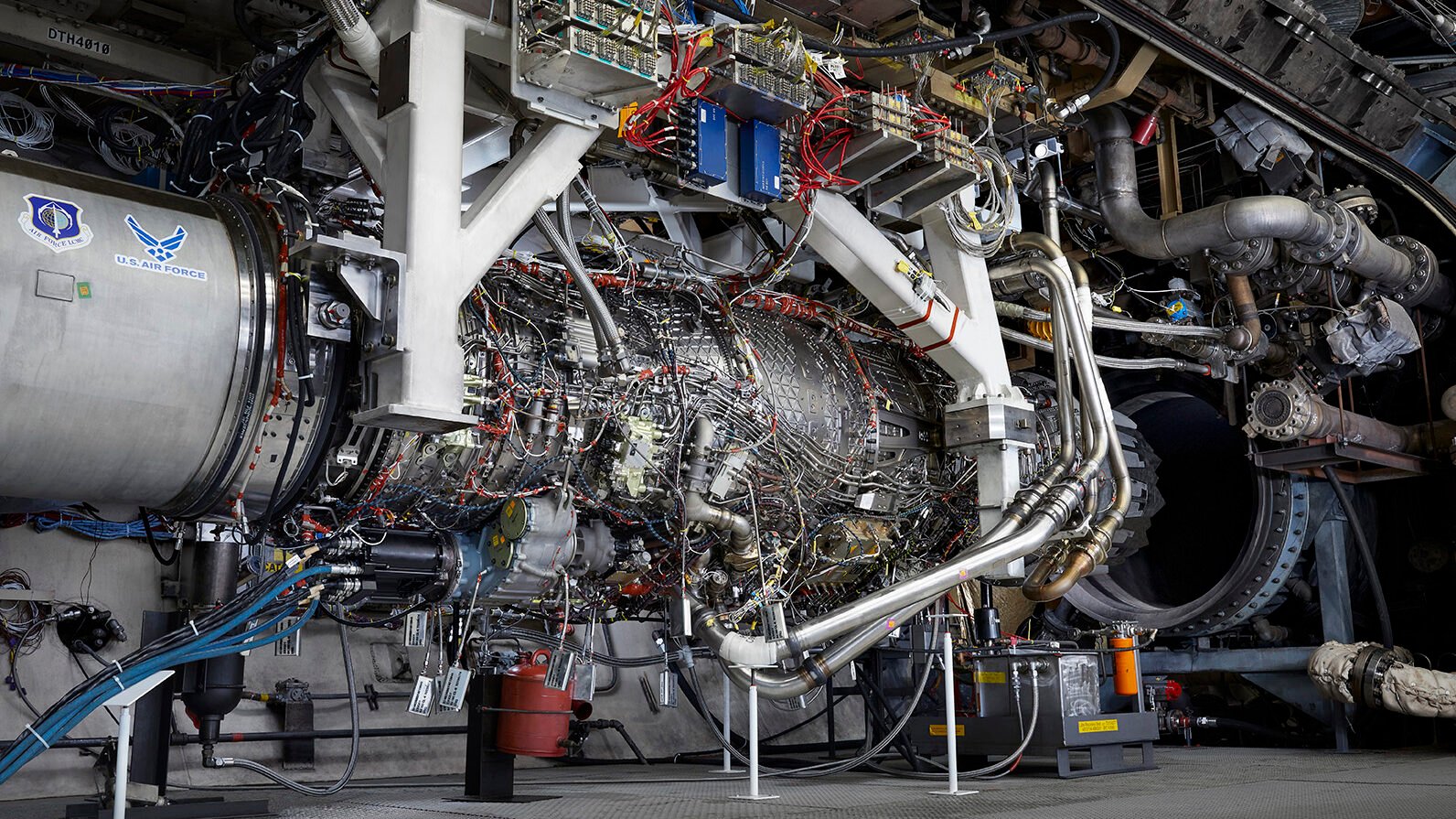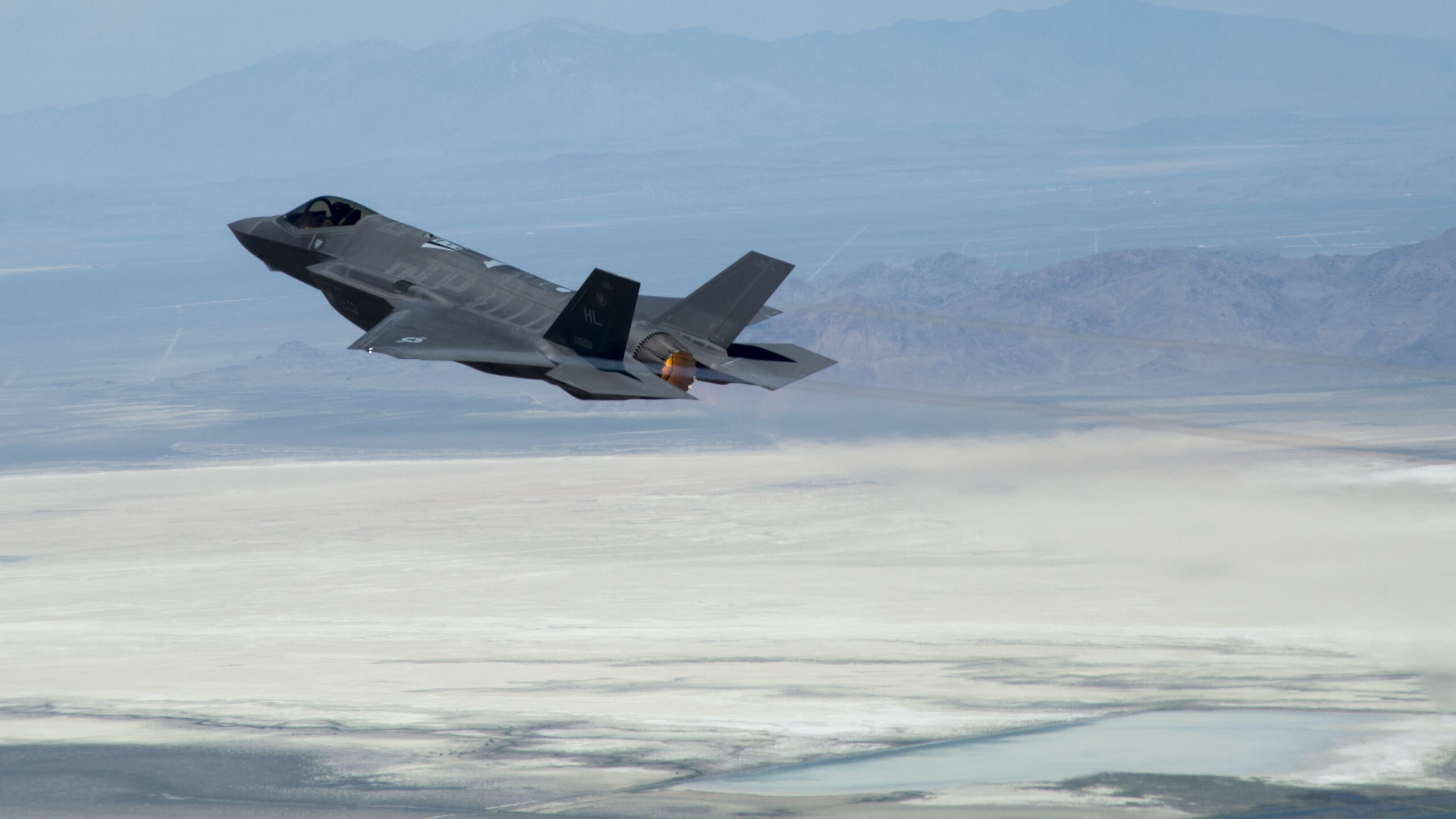
GE’s first XA100 prototype engine readies for testing in an Evendale, Ohio, test cell. (General Electric)
EVENDALE, Oh. — Inside a test cell within General Electric’s facilities here lives the XA100, a prototype adaptive engine developed by the company for the F-35 that will likely not be powering the Joint Strike Fighter anytime soon, following the Air Force’s decision to instead fund an upgrade to the jet’s current F135 powerplant made by Pratt & Whitney.
That’s why a small group of reporters, including Breaking Defense, was invited to the company’s facilities recently for a look at the engine itself, as well as the additive manufacturing techniques and ceramic matrix composites it leverages, as GE mounts a broader campaign to keep the Adaptive Engine Transition Program (AETP) alive.
“We were disappointed that the Air Force did not request the funding in the [fiscal] ‘24 budget cycle to move forward with the AETP program,” David Tweedie, GE Edison Works vice president and general manager for advanced products, said during a briefing with reporters. “That doesn’t change our perspective, that we truly believe that to keep the F-35 relevant — and not only the F-35 — but to continue this technology forward into other future platforms that adaptive cycle engines are the way to go.”
In the immediate term, GE is asking Congress for the necessary funds to carry the program “to the next logical milestone,” Tweedie said, which he explained would be roughly equivalent to a critical design review. He claimed the company could complete that task by next year, though he declined to share what that might cost taxpayers to keep the R&D effort going.
A defense professional familiar with the program told Breaking Defense that GE’s strategy isn’t aimed at derailing the upgrade path the Pentagon is currently pursuing, but instead is focused on preserving options should development of the upgraded F135 engine go awry.
“If you look at what GE is really asking for in the FY24 budget — it’s to keep their program alive. They’re not looking to kill the upgraded F135 engine. In fact, you can never do that given its importance to the F-35 community,” the person said.
“So, what this really comes down to is preserving options that may prove favorable in the future from a performance perspective and an insurance policy if the F135 has issues. Do we really want to cut that set of options off at the knees this year given what’s at stake with the F-35?,” they added.
New Power For An Old Plane
Adaptive engines can offer more fuel efficiency while cruising and greater thrust in combat by adjusting how air flows through the engine during flight, altering what’s known as its bypass ratio. The powerplant also incorporates a third stream of air that Tweedie explained is mostly used in the GE engine as an extra source of thermal management to cool off the aircraft’s subsystems.
Officials have been exploring engine modernization options — weighing a complete re-engine with an adaptive engine or an upgrade to the existing powerplant — to address power and cooling concerns with the F-35, as the program prepares to enter its next round of capability enhancements known as Block 4. To increase the fighter’s power and cooling capacity, the Pentagon this year chose to request funding for an upgrade to the existing Pratt-made engine, a plan called the Engine Core Upgrade (ECU) that officials say will provide acceptable levels of enhanced performance and be compatible with all three variants of the fighter.
Despite the attractive capabilities an adaptive engine could offer — with GE claiming improvements on the order of 30% greater range, 10% more thrust and double the current thermal management capacity through its AETP prototype — going forward with an adaptive engine is simply too expensive, Air Force Secretary Frank Kendall has previously explained, especially since the service would have to go it alone without buy-in from the Marine Corps and Navy.

A F-35 Lightning ll from the 388th Fighter Wing, Hill Air Force Base, Utah, flies over the Utah Test and Training Range (Photo: US Air Force)
As a result, Kendall announced in March that in lieu of a potential competition between GE and Pratt for an adaptive engine through AETP, the F-35 will instead be powered by an upgraded F135 engine supplied by Pratt.
Funding the ECU is likely a fait accompli — an adaptive engine currently isn’t compatible with the F-35B vertical takeoff and landing variant for the Marines, officials have said, and the Navy hasn’t expressed interest in exploring how to make one fit with the carrier-launched F-35C. But any leverage GE can gain over the F-35 fight could help it with its future opportunities.
While Tweedie emphasized the company’s goal is ultimately to power the F-35, he also detailed how AETP redounds to other ongoing adaptive engine work – specifically, a powerplant planned for the Air Force’s secretive Next Generation Air Dominance (NGAD) system.
Similar to the structure of AETP, GE and Pratt are both participating in an engine development effort for the NGAD fighter — known as the Next Generation Adaptive Propulsion (NGAP) program — that a key service official previously said could cut down to one vendor by the end of next year.
A ramp-up in funding for the program in FY24 could indicate that the Air Force intends to “provide enough funding to allow competition to carry out through a prototyping phase,” Tweedie suggested, while unveiling the name of the company’s offering for the program: the XA102.
“Our XA102 engine on the NGAP program is going to leverage heavily from what we’ve matured here,” he said. “As we continue to see where the NGAP program is heading, that’s also guiding our ability to want to go get some more test points to inform where we go forward on that program.”
Additionally, Tweedie revealed the company has launched a third testing phase for the XA100 that collects “performance-oriented data across different parts of the flight envelope,” which he said can also be used to inform work for the XA102. Although GE previously announced it had wrapped up testing for AETP, Tweedie said that the company launched another round of testing in-house because “when you’ve got a good engine and that’s running, you want to keep getting more and more data.” (Tweedie said the testing is funded by congressional appropriations previously supplied in the FY22 and FY23 budgets.)
Gearing Up For The Fight
To get its engine into the F-35, Tweedie said the company intends to wage its uphill battle by “elevat[ing] the discussion,” pointing to considerations like boosts to an aircraft’s time on station to increase fighter capacity, or “how much longer a stealthy aircraft and survivable aircraft can stay in a contested environment.”
GE is also exploring ways to bring down development costs on the front end, he said, while emphasizing savings that could be accrued throughout the engine’s lifecycle. In sum, the company claims, incorporating an adaptive engine for the F-35A would net $10 billion dollars in savings for the program, which would come on top of lifecycle cost savings that would be captured through an engine upgrade. (Without any upgrades, the current engine will need more maintenance due to excessive demands being placed on it beyond its design specifications, driving what the Government Accountability Office says [PDF] would be an added $38 billion in costs across its lifespan.)
“In that $10 billion [number is included] both the development cost and the implementation of that into a sustainment infrastructure,” Tweedie asserted, adding that the figure leaves out the fuel that would be saved on flying tankers that would no longer be needed as frequently to gas up jets.
Those considerations still have to run up against hard budget realities. In a recent interview with Breaking Defense, Rep. Rob Wittman, R-Va., chair of the House Armed Services tactical air and land subcommittee, noted that simply adding more funds to AETP’s topline isn’t a solution. Alongside the tight budget space are other challenges like developmental hurdles for fielding the engine itself, as well as the impact of incorporating a new engine design into the aircraft’s 17-member and growing international customer base.
Nevertheless, Tweedie said, the company is pressing forward to make its case to lawmakers that funding for AETP should continue, with Congress poised to weigh in within weeks.
“From our perspective, the journey does continue,” he said.






















